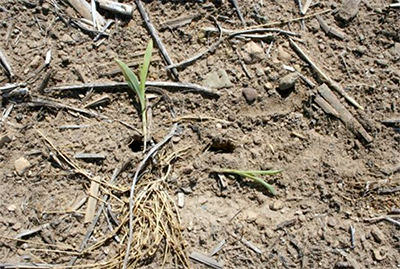New label approved for sandhill crane repellent
Protect field corn or sweet corn from sandhill cranes with Avipel (anthraquinone), an effective and non-lethal repellent seed treatment.

As populations of sandhill cranes (Grus canadensis) continue to rise throughout the Great Lakes region, conflicts between agriculture and cranes are on the rise as well. Sandhill cranes are distinguished by their predominantly gray color with white cheeks and a red crown. Their legs are long and slender, and they have a long neck and beak as well. Sandhill cranes are omnivorous and predominantly feed on invertebrates, small vertebrates, seeds, cultivated grains and berries. They migrate through Michigan in spring and fall, with some breeding pairs taking up residence for summer.
Agricultural damage from sandhill cranes most often takes the form of birds feeding on sprouting corn or wheat seed. When feeding in a corn field, they use their beak to pull out entire seedlings and then consume the seed that is still attached to the young plant. Cranes will feed on corn seeds throughout the seedling stage until the endosperm that was present in the seed is completely metabolized by the plant. This usually takes until the corn reaches the V4 stage (four leaf collars present).
Damage can be quite extensive, as cranes usually pluck sections of row throughout the field, creating extensive gaps in stands. These gaps in stand cause significant yield loss because yield from missing plants will not be compensated for by neighboring plants in adjacent rows.
Economic losses are greater in corn grown for seed, not just because seed corn is a higher value crop, but because some growers have lost seed corn contracts due to crane damage being a persistent problem. Large congregations of juvenile birds are responsible for a greater proportion of damage due to their numbers and because they are more likely to move around. Fields at the highest risk are usually wetter fields, or those adjacent to wetlands, and fields isolated from human activity.

There are a few methods available for reducing sandhill crane damage in field crops. Deploying scare tactics may work to some extent and lethal removal does help to reinforce scare tactics. However, due to the federal protection of sandhill cranes, depredation permits from the U.S. Fish and Wildlife Service must be obtained before employing lethal controls. Both tactics are time consuming, as they require monitoring the field and waiting for cranes to show up.
Scare tactics and lethal control may also move cranes to neighboring fields, and thus spread rather than reduce damage. Furthermore, sandhill cranes are known to return to a field and continue feeding after a threat is removed.
Another method of controlling crane damage that is gaining popularity is using Avipel (anthraquinone), a non-lethal repellent seed treatment. Sandhill cranes that ingest Avipel-treated seeds experience immediate, but harmless, digestive repellency and will learn to avoid eating those treated seeds. Research has proven this to be an effective method for reducing crane damage. Cranes may still be present in treated fields, but they will instead feed on insects like grubs and caterpillars.
Prior to 2019, Avipel has been used in Michigan under a Section 24(c) exemption. However, in 2019 Avipel received approval from the EPA for a new federal label, expanding registration to all 50 states for use in field corn and sweet corn. Avipel comes in dry and liquid formulations, is compatible with existing seed treatments and can be purchased from most agricultural input suppliers.
For more information on sandhill crane damage or to request depredation permits, contact USDA Wildlife Services. For more information on Avipel seed treatment, contact Arkion Life Sciences or your local agriculture input supplier.



 Print
Print Email
Email